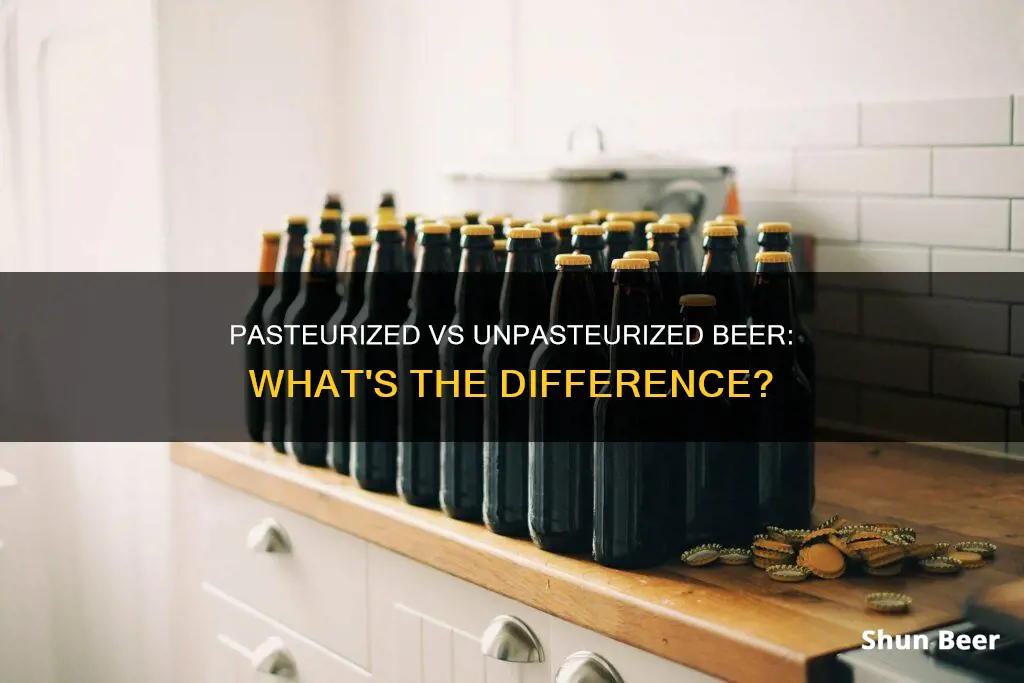
Pasteurized vs. unpasteurized beer: what's the difference? Pasteurization is the process of heating beer to a high temperature to kill any living microbes, which can help improve shelf life and standardize taste. However, this process can negatively impact the flavor of the beer. Unpasteurized beer, on the other hand, is often considered fresher and tastier, with more health benefits due to the presence of live yeast and enzymes. While pasteurization is commonly used for commercial beers, many craft breweries opt to skip this step to preserve the flavor and freshness of their brews.
What You'll Learn

Pasteurization kills living microbes in beer
Pasteurization is the process of heating beer to a temperature that kills any living microbes. It is used by some brewers to sterilize and stabilize their product without changing its chemistry or flavour. Pasteurization extends the shelf life of beer, which can then be kept at room temperature without spoilage.
The process was invented by French scientist Louis Pasteur in the 1870s, who sought to improve the taste of French beer and prevent it from spoiling. Pasteur noted that beer fermented at higher temperatures would spoil faster, so he patented a process to expose bottles of beer to extremely high temperatures, killing all "extraneous germs of undesirable ferments".
The process of pasteurization can, however, negatively impact the flavour of the beer, as aromas tend to be lost and the flavour is 'flattened'. This is why many craft breweries are increasingly choosing not to pasteurize their beers.
Budlight vs Amber Beer: Taste, Color, and Alcohol Content
You may want to see also

Unpasteurized beer has better taste and health benefits
Pasteurization is the process of heating beer to a temperature that will kill any living microbes. It is used by some brewers to sterilize and stabilize their product without changing the chemistry or flavor. However, unpasteurized beer has several benefits over its pasteurized counterpart.
Firstly, unpasteurized beer has a better taste. Those who prefer unpasteurized beers say that the process gives the brew a 'burnt sugar' flavor, and that pasteurization and excessive filtering ruin the true flavor of the beer. Unpasteurized beer is also known as "live beer" because it contains living microorganisms such as yeast, which is one of the most effective ways of getting vitamin B complexes. The B vitamins also help counteract hangovers, another added benefit of unpasteurized beer.
Unpasteurized beer also has several health benefits. It contains live yeast, which provides the drinker with B vitamins, which can help improve mental health and reduce anxiety and depression. Unpasteurized beer also contains lactobacillus, a beneficial bacteria found in fermented vegetables and dairy products like yogurt and kefir. Drinking unpasteurized beer may also help prevent Alzheimer's disease by reducing aluminum intake in the digestive tract and slowing the accumulation of metal in the body and brain tissue.
Craft breweries often forgo the pasteurization process for some or all of their beers. Pasteurization equipment is expensive, and craft breweries design their beers to be consumed in the tap room or within a short window of time close to the brewery.
Exploring the Diverse US Beer Scene
You may want to see also

Pasteurization improves shelf life and taste standardization
Pasteurization is a process that can dramatically improve a beer's shelf life. Beer is an ideal home for tiny organisms invisible to the naked eye. If it isn't stored correctly, microbes and other contaminants can cause infection. Pasteurization is a way to prevent this. The process involves heating beer to a temperature that kills any living microbes. This prevents spoilage and prolongs shelf life.
The process was invented by Louis Pasteur in the 1800s. Pasteur discovered that heating beer defeats spoilage by microorganisms. Pasteurization is different from sterilization because it doesn't kill all bacteria or microbes. Instead, it uses just enough heat to prevent the beer from spoiling while retaining its flavour and prolonging its shelf life.
There are two methods of pasteurization: flash pasteurization and tunnel pasteurization. Flash pasteurization involves heating beer to a high temperature but for a short period. This method is also known as "high-temperature short-time" (HTST) processing. Beer that has been flash pasteurized is then cooled rapidly before being filled into sterile containers. A tunnel pasteurizer, on the other hand, heats beer at a slightly lower temperature but for a longer period. Bottled and canned beers are passed through a long, narrow chamber and sprayed with hot water before being cooled.
Pasteurization can also help with the standardization of taste. While some argue that heat pasteurization robs the beer of its flavour, others claim that there is no discernible effect. The process of flash pasteurization, in particular, helps to reduce the impact on flavour. This is because less time at higher temperatures is generally better for the beer. The rapid heating and cooling during flash pasteurization can help to preserve the flavour of the beer.
Cask Ale and Beer: What's the Difference?
You may want to see also

Unpasteurized beer needs to be continuously chilled
Pasteurization is a process of heating beer to a temperature that kills any living microbes, which can prevent food spoilage and stabilize the product without changing its chemistry or flavor. The process was perfected by French scientist Louis Pasteur in the 1870s to make French beer taste better and last longer.
Unpasteurized beer, on the other hand, is a product that hasn't been through the pasteurization process. It is often referred to as "live" beer because it contains living microorganisms such as yeast. While pasteurization can alter the taste and destroy the natural yeast and enzymes in beer, unpasteurized beer is believed to have better taste and potential health benefits.
However, the lack of pasteurization means that unpasteurized beer needs to be handled with more care. To keep untreated beers fresh, they need to be continuously chilled. This is because the aging process works faster at warmer temperatures, and unpasteurized beer is more susceptible to spoilage. By keeping the beer chilled, it can be preserved and consumed within its ideal window of freshness, which is typically within 45 to 60 days of the production date.
It is important for consumers to ensure that the unpasteurized beer they purchase has been kept cold from the time of production until it is opened and consumed. This continuous chilling is crucial to maintaining the quality and safety of the beer. Without pasteurization, the beer is more vulnerable to spoilage, and chilling helps to slow down any unwanted changes in taste or texture.
In summary, unpasteurized beer needs to be continuously chilled to maintain its freshness, quality, and safety. This is a crucial step in the handling of unpasteurized beer to ensure that consumers can enjoy the product as intended by the brewer.
Beer vs. Malt Liquor: Understanding the Core Distinction
You may want to see also

Pasteurization was invented by Louis Pasteur in the 1870s
Pasteurization, named after French scientist Louis Pasteur, was invented in the 1870s—specifically, 1873, when Pasteur was granted a US patent for "Improvement in Brewing Beer and Ale Pasteurization". Pasteurization is the process of heating beer to a temperature that kills any living microbes, thereby sterilizing and stabilizing the beverage without changing its chemistry or flavor.
Pasteur's work in this area was a natural progression from his earlier research. In 1856, Pasteur discovered that yeast, a living organism, turns beet juice into alcohol. He noticed that when the alcohol spoiled, it contained a different, rod-shaped microbe. This discovery formed the basis of his germ theory of fermentation, which he would later apply to the origins of disease, making some of his greatest contributions to science and medicine.
Emperor Napoleon III then enlisted Pasteur to save France's wine industry from the "diseases of wine". In previous experiments, Pasteur had discovered that heating wine would kill the microbes that caused it to spoil. He determined the exact time and temperature that would kill harmful microorganisms without changing the wine's taste. He patented this process and called it pasteurization. Before long, the process was also used for beer and vinegar.
Pasteurization of milk did not come into practice until the late 1800s, when tuberculosis was commonly carried by milk. A low-temperature, long-time process was first developed to kill the tuberculosis pathogen, dramatically reducing the incidence of the disease. The first commercial milk pasteurizers were produced in 1882, using a high-temperature, short-time process.
Beer vs Vodka: Understanding Alcoholic Beverage Differences
You may want to see also
Frequently asked questions
Pasteurization is the process of heating beer to a temperature that will kill any living microbes. It is used by some brewers to sterilize and stabilize their product without changing its chemistry or flavor.
Pasteurization is done to increase the shelf life of the beer, help with standardization of taste, and allow the beer to be stored at room temperature without spoilage.
The rapid heating and chilling of pasteurization can negatively affect the flavor of the beer. Aromas tend to be lost, and the flavor of the beer is ‘flattened’.
Unpasteurized beer is considered to be fresher and tastier. It also contains live yeast and enzymes that are good for gut health.
Yes, drinking unpasteurized beer is safe. The alcohol in the beer kills any harmful bacteria.







